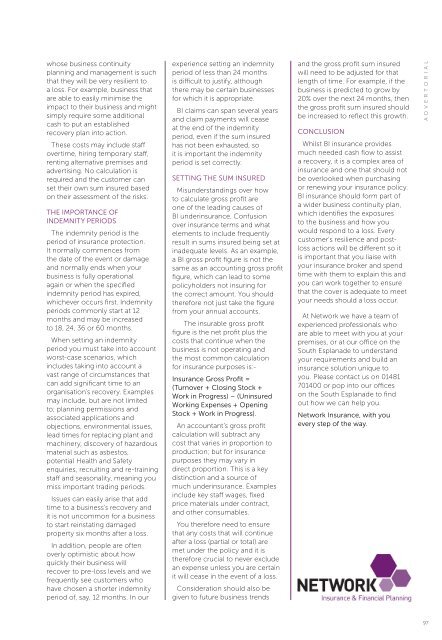0299 AUR En Voyage Issue #18 Flickbook
You also want an ePaper? Increase the reach of your titles
YUMPU automatically turns print PDFs into web optimized ePapers that Google loves.
whose business continuity<br />
planning and management is such<br />
that they will be very resilient to<br />
a loss. For example, business that<br />
are able to easily minimise the<br />
impact to their business and might<br />
simply require some additional<br />
cash to put an established<br />
recovery plan into action.<br />
These costs may include staff<br />
overtime, hiring temporary staff,<br />
renting alternative premises and<br />
advertising. No calculation is<br />
required and the customer can<br />
set their own sum insured based<br />
on their assessment of the risks.<br />
THE IMPORTANCE OF<br />
INDEMNITY PERIODS<br />
The indemnity period is the<br />
period of insurance protection.<br />
It normally commences from<br />
the date of the event or damage<br />
and normally ends when your<br />
business is fully operational<br />
again or when the specified<br />
indemnity period has expired,<br />
whichever occurs first. Indemnity<br />
periods commonly start at 12<br />
months and may be increased<br />
to 18, 24, 36 or 60 months.<br />
When setting an indemnity<br />
period you must take into account<br />
worst-case scenarios, which<br />
includes taking into account a<br />
vast range of circumstances that<br />
can add significant time to an<br />
organisation's recovery. Examples<br />
may include, but are not limited<br />
to; planning permissions and<br />
associated applications and<br />
objections, environmental issues,<br />
lead times for replacing plant and<br />
machinery, discovery of hazardous<br />
material such as asbestos,<br />
potential Health and Safety<br />
enquiries, recruiting and re-training<br />
staff and seasonality, meaning you<br />
miss important trading periods.<br />
<strong>Issue</strong>s can easily arise that add<br />
time to a business’s recovery and<br />
it is not uncommon for a business<br />
to start reinstating damaged<br />
property six months after a loss.<br />
In addition, people are often<br />
overly optimistic about how<br />
quickly their business will<br />
recover to pre-loss levels and we<br />
frequently see customers who<br />
have chosen a shorter indemnity<br />
period of, say, 12 months. In our<br />
experience setting an indemnity<br />
period of less than 24 months<br />
is difficult to justify, although<br />
there may be certain businesses<br />
for which it is appropriate.<br />
BI claims can span several years<br />
and claim payments will cease<br />
at the end of the indemnity<br />
period, even if the sum insured<br />
has not been exhausted, so<br />
it is important the indemnity<br />
period is set correctly.<br />
SETTING THE SUM INSURED<br />
Misunderstandings over how<br />
to calculate gross profit are<br />
one of the leading causes of<br />
BI underinsurance. Confusion<br />
over insurance terms and what<br />
elements to include frequently<br />
result in sums insured being set at<br />
inadequate levels. As an example,<br />
a BI gross profit figure is not the<br />
same as an accounting gross profit<br />
figure, which can lead to some<br />
policyholders not insuring for<br />
the correct amount. You should<br />
therefore not just take the figure<br />
from your annual accounts.<br />
The insurable gross profit<br />
figure is the net profit plus the<br />
costs that continue when the<br />
business is not operating and<br />
the most common calculation<br />
for insurance purposes is:-<br />
Insurance Gross Profit =<br />
(Turnover + Closing Stock +<br />
Work in Progress) – (Uninsured<br />
Working Expenses + Opening<br />
Stock + Work in Progress).<br />
An accountant’s gross profit<br />
calculation will subtract any<br />
cost that varies in proportion to<br />
production; but for insurance<br />
purposes they may vary in<br />
direct proportion. This is a key<br />
distinction and a source of<br />
much underinsurance. Examples<br />
include key staff wages, fixed<br />
price materials under contract,<br />
and other consumables.<br />
You therefore need to ensure<br />
that any costs that will continue<br />
after a loss (partial or total) are<br />
met under the policy and it is<br />
therefore crucial to never exclude<br />
an expense unless you are certain<br />
it will cease in the event of a loss.<br />
Consideration should also be<br />
given to future business trends<br />
and the gross profit sum insured<br />
will need to be adjusted for that<br />
length of time. For example, if the<br />
business is predicted to grow by<br />
20% over the next 24 months, then<br />
the gross profit sum insured should<br />
be increased to reflect this growth.<br />
CONCLUSION<br />
Whilst BI insurance provides<br />
much needed cash flow to assist<br />
a recovery, it is a complex area of<br />
insurance and one that should not<br />
be overlooked when purchasing<br />
or renewing your insurance policy.<br />
BI insurance should form part of<br />
a wider business continuity plan,<br />
which identifies the exposures<br />
to the business and how you<br />
would respond to a loss. Every<br />
customer's resilience and postloss<br />
actions will be different so it<br />
is important that you liaise with<br />
your insurance broker and spend<br />
time with them to explain this and<br />
you can work together to ensure<br />
that the cover is adequate to meet<br />
your needs should a loss occur.<br />
At Network we have a team of<br />
experienced professionals who<br />
are able to meet with you at your<br />
premises, or at our office on the<br />
South Esplanade to understand<br />
your requirements and build an<br />
insurance solution unique to<br />
you. Please contact us on 01481<br />
701400 or pop into our offices<br />
on the South Esplanade to find<br />
out how we can help you.<br />
Network Insurance, with you<br />
every step of the way.<br />
ADVERTORIAL<br />
97
















